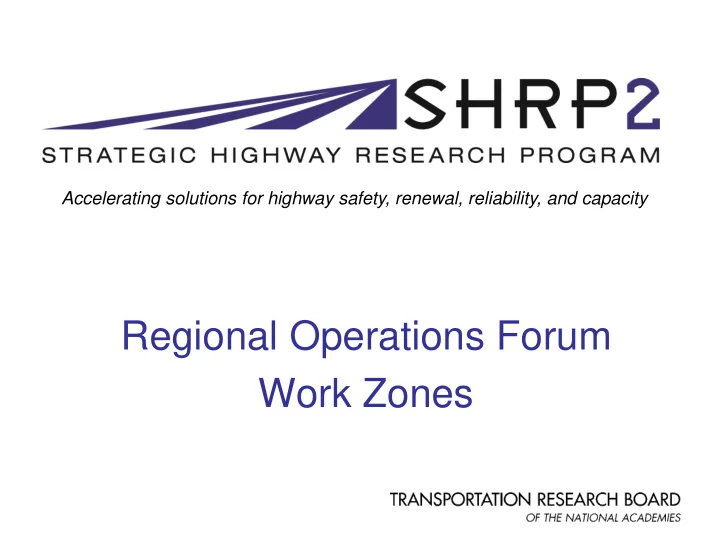

Accelerating solutions for highway safety, renewal, reliability, and capacity Regional Operations Forum Work Zones
Work Zone Challenges • Construction worker and road user safety • Work zone (WZ) congestion and delay • Roadway capacity and speed reductions • Alternate routing and travel route availability • Day and nighttime condition awareness • Traffic pattern changes • Incident management 2
Types of Work Zones Five categories: 1. Mobile 2. Short duration 3. Short-term stationary 4. Intermediate-term stationary 5. Long-term 3
Policies: Facilitators of WZ Management • Provides guidance/direction for work zone management – Systematic consideration of work zone impacts – All stages of project development – Addresses safety and mobility needs of travelers/ workers • Work Zone Safety and Mobility Rule – http://www.ops.fhwa.dot.gov/wz/resources/final_rule/language.htm • Can encourage use of specific strategies the agency has found effective, such as ITS 4
Work Zone Safety and Mobility Final Rule • Established requirements for – Systematically addressing WZ safety and mobility – Develop strategies to manage impact on federal-aid highway projects • Published: September 2004 • Effective date: October 2007 • Required agencies to develop WZ policy 5
Examples of Work Zone Policies • Washington State DOT – Secretary’s Executive Order, February 2007 – WSDOT must make “safety of workers and the traveling public our highest priority during roadway design, construction, maintenance, and related activities” – Sets out responsibilities • Utah DOT – Requires TMP – Sets out responsibilities – Establishes “Traffic Guidelines for Work Zone Safety and Mobility” • www.ops.fhwa.dot.gov/wz/resources/final_rule/policy_examples.htm 6
What is a TMP? • Transportation Management Plan (TMP) • Design documents show how a project will be built • Shows how traffic will be managed during construction • Required on ALL federal-aid projects • Scalable to the type of project being considered • Considered a living document 7
TMP Development Process FHWA Work Zone Mobility Final Rule “Developing and Implementing Transportation Management Plans for Work Zones”
Example TMP 11
WZ Management Strategies • Traffic control • Contract incentives • Accelerated construction • Contraflow lanes • Demand management • Traveler information 12
Opportunities for Coordination • TMPs require coordination with surrounding projects. • What happens when coordination doesn’t exist? 13
Work Zone ITS • Traffic management systems – Traditional traffic management • Monitoring • Signals • Ramp metering – Dynamic merge systems – Variable speed limit/active traffic management (ATM) systems • Traveler information systems • Incident management systems • Intrusion alarm systems • Automated speed enforcement/feedback systems 14
Dynamic Merge Systems • Dynamic signs and devices control vehicle merging approaching lane closures • Changes lane use instructions based on current traffic conditions • Sensors determine congestion level or queue length • “Early” and “Late” 15
Dynamic Early Merge • Addition to standard traffic control • No passing zone at back of queue – Detected by temporary speed detection • Fixed no passing signs – Flashers indicate no passing zone 16
Dynamic Late Merge • Addition to standard traffic control • Easy trailer mounted DMS deployment • Fast adjustments • DMS active only when congested periods 17
Dynamic Late Merge 1st Sign – Approximately 3 miles upstream 18
Dynamic Late Merge 2nd Sign - 1.5 miles from Taper 19
Dynamic Late Merge 3rd Sign – Located at Taper 20
Variable Speed Limit • Provides ability to set speed limit based on work zone conditions – Type of work being done – Characteristics of work zone 21
New Mexico DOT ITS Benefits • The Big I Reconstruction project • NO FATALITIES • Reduced crashes and secondary crashes by 32% • Reduced incident management times from 45 to 25 min • Saved effort through automation • Reduced traffic through work zone 23
Other Examples • New Jersey I-295 Project – Real-time travel times • I-93 in Salem, New Hampshire – Changeable message signs, sensors, cameras – Work zone travel conditions via the Internet • I-295 in Washington, DC – Real-time traffic information via Internet • http://www.ops.fhwa.dot.gov/wz/its/index.htm 24
GROUP DISCUSSION 25
Best Practices – New York City DOT Online Mapping 26
Best Practices – Oregon DOT Corridor-Level TMPs 27
Best Practices – VDOT LCAMS 28
SHRP 2 Project R11 • WISE Software (Work Zone Impact and Strategy Estimator software). Goals: – Document effective practices for executing highway renewal activities – Examples of agency and project org. designs – Develop new tools, techniques, and processes – Provide guidance for selecting tools, techniques, performance measures, and practices – Assess and develop training needs and materials • Project is complete with planning and operations modules 29
Recommended Resources • Work Zone Safety and Mobility Final Rule http://www.ops.fhwa.dot.gov/wz/resources/final_rule/lang uage.htm • Developing and Implementing Transportation Management Plans for Work Zones http://www.dot.state.mn.us/trafficeng/otepubl/fhwa/trans- mgmt-plans.pdf • Freeway Management Handbook http://ops.fhwa.dot.gov/freewaymgmt/publications/frwy_ mgmt_handbook/toc.htm 30
Additional Resources • FHWA work zone website http://www.ops.fhwa.dot.gov/wz/index.asp • National Work Zone Safety Information Clearinghouse http://www.workzonesafety.org/about/ • Work zone resources http://www.ite.org/education/Workzones/ • Coordinating, Planning, and Managing the Effects of Roadway Construction with Technology http://www.its.dot.gov/press/2009/road_construction_tech.htm • AASHTO’s ITS in work zones http://www.transportation.org/?siteid=42&pageid=1939 31
Additional Resources • ITS Safety and Mobility Solutions: Improving Travel Through America's Work Zones http://www.atssa.com/galleries/default- file/2008July21_ITS_Safety_and_Mobility.pdf • Minnesota Intelligent Work Zone Toolbox http://www.dot.state.mn.us/trafficeng/workzone/iwz/MN- IWZToolbox.pdf • Comparative Analysis Report: The Benefits of Using Intelligent Transportation Systems in Work Zones http://www.ops.fhwa.dot.gov/wz/its/wz_comp_analysis/c omp_anl_rpt_08.pdf 32
Additional Resources • Work Zone Operations Best Practice Guidebook http://www.ops.fhwa.dot.gov/wz/practices/best/bestpracti ces.htm • NCHRP Synthesis 379: Selection and Evaluation of Alternative Contracting Methods to Accelerate Project Completion http://onlinepubs.trb.org/onlinepubs/nchrp/nchrp_syn_37 9.pdf • WSDOT ATM SOP: (section F covers ATM in work zones) http://www.wsdot.wa.gov/NR/rdonlyres/788B7FFC- 6BE3-426A-9882- 0430180900A6/0/StandardOperatingProceduresdraftv62 .pdf 33
Homework Takeaways • Follow the Work Zone Safety and Mobility Final Rule • Where does operations fit in TMP development within your agency? – Are you involved at the right level and stage? – If not, who can help to get you there? • What new capabilities, resources, or knowledge will help to benefit planned special event operations in your region? • Do cost management and recovery. 34
Recommend
More recommend